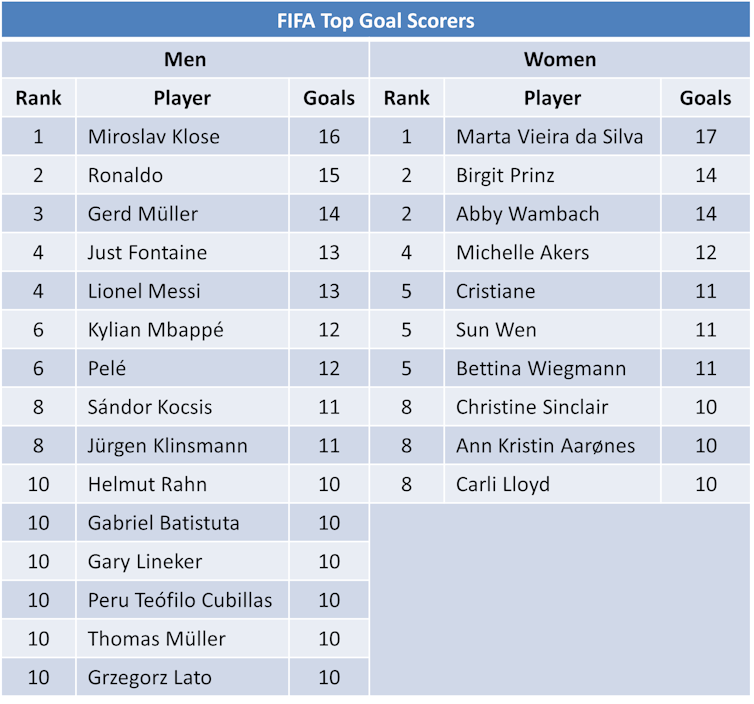Few events capture the global imagination the way the FIFA World Cup does. The tournament is more than just a series of soccer matches; it’s a cultural phenomenon that transcends borders, languages and social categories.
However, there has been a glaring disparity between the men’s and women’s World Cups regarding viewership, financial investment and media coverage.
The men’s World Cup has a long and storied history dating back to its inception in 1930. Over the years, it has grown exponentially regarding viewership and financial investment. The tournament has been a platform for legendary players like Pelé, Diego Maradona and Lionel Messi to showcase their talents on the world stage.
In contrast, the women’s World Cup was launched by FIFA much later, in 1991. Despite its relatively short history, the tournament has made significant strides, with players like Mia Hamm, Christine Sinclair, Megan Rapinoe, Abby Wambach and Marta Vieira da Silva becoming household names.
Rapid growth, unequal playing conditions
The growth of the FIFA Women’s World Cup reveals a compelling narrative about the rapid progress of women’s soccer. The men’s World Cup grew from 18 to 64 matches, with a total attendance increasing from nearly 590,500 in 1930 to about 3.4 million in 2022.
Similarly, the total attendance for the women’s World Cup surged from approximately 510,000 in 1991 to nearly two million in 2023.
Starting 61 years later than the Men’s World Cup, the women’s tournament expanded from 26 to 64 matches in just 32 years, catching up with the men’s format.
Regarding average attendance, the women’s World Cup has almost doubled from around 19,600 to nearly 30,900 in 32 years, while the men’s average attendance increased from about 32,800 to almost 53,200 over 93 years. These trends suggest the women’s World Cup is not only catching up to the men’s World Cup, but is doing so at a much faster rate.
If this rapid growth continues, the women’s World Cup could match or surpass the men’s in total and average attendance in the coming decades.
Numerous challenges
The women’s World Cup has faced numerous challenges, including fewer teams, shorter matches and artificial turf compared to the men’s natural grass. Financial and media disparities persist. The 2019 women’s World Cup had a prize pool of US$30 million — a fraction of the US$400 million allocated for the 2018 men’s World Cup.
Although the 2023 women’s event has seen a significant increase in prize money to US$110 million, it still pales in comparison to the US$440 million for the 2022 men’s World Cup.
This financial imbalance extends beyond the players to the tournament itself, with the men’s World Cup attracting more high-profile sponsors. As a result, female athletes receive less professional recognition and fewer resources than the men do.
Read more: FIFA Women’s World Cup: Professional women athletes are still fighting for equitable sponsorship
Media coverage for the women’s World Cup is improving, closing the gap with the men’s tournament. The 2019 and 2023 editions set new viewership records.
Media coverage of the FIFA Women’s World Cup not only changes normative expectations about what women can achieve in sports but also serves as a platform for creating female role models and breaking long-standing gender stereotypes. This heightened visibility positively influences public beliefs about women’s capabilities in traditionally male-dominated fields.
For example, FIFA’s appointment of three women referees and three women assistant referees in 2022 serves as a sign of changing employment opportunities. As a result, these shifts in perception may affect income disparities and career advancement for women.
Gender parity in world soccer
Despite the ongoing inequalities, the skill level between men’s and women’s soccer is comparable. For instance, Brazilian forward Marta set a milestone by scoring 17 goals in a World Cup competition, surpassing Miroslav Klose’s previous record of 16 goals in 2019.
The range of goals scored by the Top 10 men and women players is similar, suggesting a comparable level of competition and skill.

The women’s World Cup has come a long way, but the road to gender equality remains long and fraught. Still, the trajectory is clear: with rising viewership, burgeoning sponsorships and an ever-expanding talent pool, the future is not just promising — it’s luminous.
With an unprecedented two million fans flooding the stadiums in 2023, it’s clear the world is finally recognizing the extraordinary skill and electrifying excitement that women bring to soccer. Milestones like the 2023 expansion to 32 teams and standardizing match duration indicate progress as well.
But this is no time for complacency. Equity isn’t merely about filling stadiums or equalizing prize money; it’s a battle against entrenched stereotypes that have stifled women’s sports for far too long.
We’re at a pivotal moment, and the time for action is now. Governments, sporting bodies and organizations must keep investing in women’s soccer to champion these phenomenal athletes and make tuning into the women’s World Cup as second nature as watching the men’s tournament. Soccer is more than a game; it’s a movement shaping the future — one we all have a vested interest in.
Clare Ardern previously received funding from the Australian National Health & Medical Research Council and the Swedish Research Council for Sport Science. She is Editor-in-Chief of the Journal of Orthopaedic & Sports Physical Therapy and JOSPT Open, which are published by Movement Science Media.
Karim Khan is the Scientific Director for the CIHR institution of Musculoskeletal Health and Arthritis.
Sabeena Jalal does not work for, consult, own shares in or receive funding from any company or organisation that would benefit from this article, and has disclosed no relevant affiliations beyond their academic appointment.
This article was originally published on The Conversation. Read the original article.







